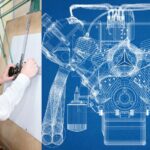When exploring the world of classic Mercedes-Benz models, two codes that often arise in discussions are C107 and R107. Both codes refer to distinct vehicles that share similarities but also have notable differences. In this article, we delve into the distinctions between the C107 and R107, shedding light on their unique characteristics and helping enthusiasts understand the nuances between these iconic Mercedes-Benz models.
Defining the Codes
To understand the differences between the C107 and R107, it is essential to grasp their individual definitions. The C107 refers to the Mercedes-Benz SLC (Coupé), which was produced from 1971 to 1981. On the other hand, the R107 designates the Mercedes-Benz SL (Roadster), which enjoyed a production run from 1971 to 1989. Although these models share a common platform, they were designed to cater to different automotive preferences.
Body Styles and Configurations
The most apparent distinction between the C107 and R107 lies in their body styles. The C107, often referred to as the “Coupé,” features a fixed roof with a pillar structure, offering a more enclosed and refined driving experience. It was designed for those seeking a luxurious and comfortable grand touring coupe.
Conversely, the R107, known as the “Roadster,” boasts a classic convertible design with a retractable soft-top. It embodies the spirit of open-air driving, emphasizing the joy of cruising under the sky while exuding a sense of elegance and timeless style.
Wheelbase Differences
Another significant difference between the C107 and R107 lies in their wheelbases. The C107 had a longer wheelbase compared to the R107, providing additional space and comfort for rear-seat passengers. This longer wheelbase made the C107 more suitable for extended journeys or accommodating a small family, making it an appealing choice for those prioritizing passenger comfort.
Performance and Handling
In terms of performance and handling, the C107 and R107 shared many similarities. Both models were available with various engine options, including inline-six and V8 powerplants, providing respectable power and smooth driving characteristics. Suspension systems, braking technology, and overall handling capabilities were also quite similar between the two models, delivering a balanced and enjoyable driving experience.
Popularity and Collectability
The R107, being a convertible roadster, gained more popularity and recognition compared to the C107. Its timeless design, open-top driving experience, and association with luxury and elegance have made it a highly sought-after classic car. The R107 holds a special place in automotive enthusiasts’ hearts and often commands higher prices in the collector car market.
The C107, while less well-known, still has its own dedicated fan base. Its coupe configuration and emphasis on comfort and refinement appeal to those seeking a more sophisticated driving experience. Collectors who appreciate its unique qualities often find the C107 to be an intriguing choice for their collection.
Conclusion
While the C107 and R107 models share a common platform and were produced during the same period, they possess distinctive characteristics that set them apart. The C107, with its coupe body style and longer wheelbase, caters to those seeking a refined grand touring experience. On the other hand, the R107, with its classic roadster design and open-air driving, embodies the spirit of luxury and timeless elegance.
By understanding the differences between the C107 and R107, enthusiasts can make more informed decisions when it comes to choosing their preferred model. Whether one gravitates towards the enclosed comfort of the C107 or the exhilaration of top-down driving in the R107, both models represent significant chapters in the rich heritage of Mercedes-Benz and continue to captivate classic car enthusiasts around the world



